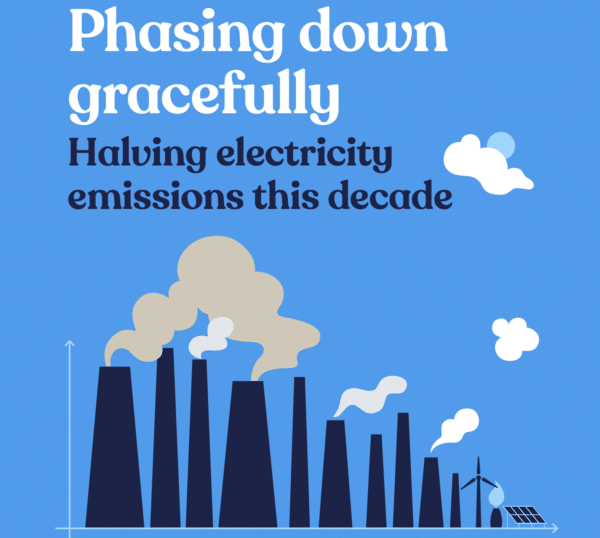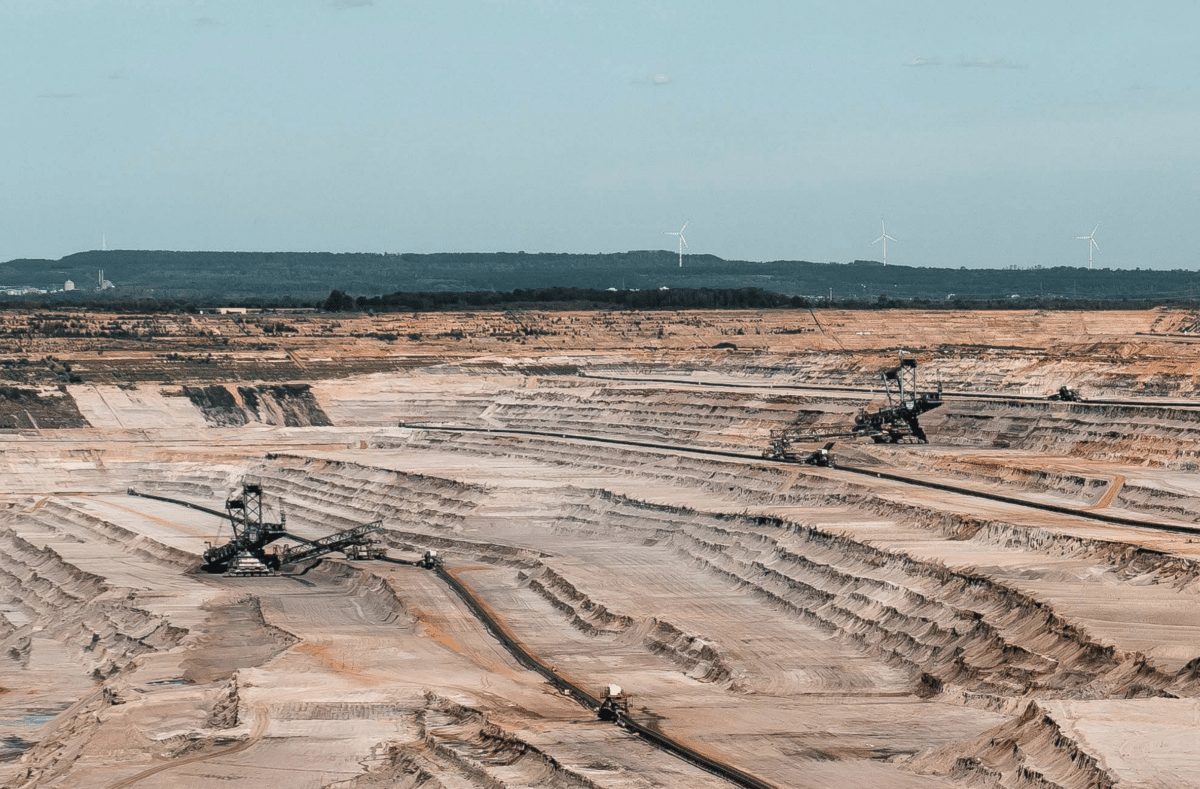When a rational centre right think tank calls for the Commonwealth Government to “step up” and “co-ordinate an orderly phase down” of emissions from electricity, and commit to cuts of 50% over the coming 10 years to 2030, you know the support for dithering is withering.
The Blueprint Institute was founded in January this year by Harry Guinness, former policy advisor to Julie Bishop, Lachlan Crombie known for contributing to NSW state policy and law reforms, and Ian Hancock, Managing Director of government-relations consultancy PremierState, and has become established in the era of Covid-19. Its “Strategic Council” includes former Liberal senator Robert Hill, former Liberal MP Christopher Pyne, and former NSW politicians, Wendy Machin, Bruce Baird and Adrian Piccoli.
Today it published a report Phasing down gracefully: halving electricity emissions this decade, which lays out the argument and a plan for exiting coal generation and transitioning workers and the economy towards a cleaner future.
A release accompanying the report notes that, “Given the states are already committed to forcing renewables into the grid at record pace”, Australia could reach its current 2030 target of 26-28% emissions reduction compared to 2005 levels, but that “this ad-hoc and scattershot process will be unnecessarily costly, and poses significant risks” that include energy supply shortfalls, price spikes and the sacrifice of workers’ livelihoods.
“We need national leadership to secure certainty for energy communities, workers, consumers and investors around the inevitable phasedown of coal-fired generation,” says the group.

Image: Blueprint Institute
Paying to reduce emissions: money well spent
At the heart of the Blueprint Institute plan is the payment of compensation to coal-fired power stations that close by an agreed deadline — rather than closing when they become inoperable or unviable in comparison with cheaper renewable generation, as was the case with Victoria’s Hazelwood Power Station (closed with only five months’ notice in 2017), and the Port Augusta plant (closure brought forward to May 2016, with only five months’ notice) in South Australia.
Both unexpected closures resulted in price spikes that reverberated across state borders due to ill-preparedness and resulting constrained supply in the National Electricity Market (NEM).
As Phasing down gracefully points out, Liddell Power Station, which extended its planned closure date from the end of 2022 to April 2023 to maintain supply during that summer period, experienced a sudden failure in one of its four units, which severely injured a worker. The ageing plant is currently limping on two units, with one not expected to be back online until March 2021.
As a result of the accident, wholesale prices surged to the maximum of $15,000 per megawatt hour, forcing the Tomago aluminium smelter to reduce production.
This is the kind of “uncontrolled detonation” of the system that Blueprint Institute seeks to avoid.
Instead, its Coal-generation Phasedown Mechanism (CPM) would see a competitive reverse auction process, overseen by the Clean Energy Regulator, that would allow coal-fired plant operators to specify the level of compensation they require to close the plant by an agreed date.
That date would typically be in advance of currently estimated retirement dates, and pegged to one of three electricity sector emissions targets — for 2026, 2028 and beyond 2030 — thereby more quickly reducing Australia’s emissions than if the plants were allowed to run for the remainder of their operational lives.
Aligning new renewable capacity and worker retraining with coal-fired closures
Known plant closures would provide certainty to renewable developers, helping to ensure that adequate replacement generation — solar and wind, backed by firmed capacity from batteries, hydro and gas — comes online at the right time to replace coal-generated gigawatts.
Coal-fired generation now contributes 89% of electricity sector emissions; “at current emission levels, a 38% reduction in our coal emissions would be sufficient to meet our Paris target”, says the Blueprint report.
The contractual arrangements for planned plant closure would, according to Blueprint Institute’s CPM, also impose obligations to workers affected by the shutdowns, such that generators would be required to offer redeployment opportunities, or retraining, or generous remuneration should retrenchment be necessary.
Phasing down gracefully argues that job losses due to a commitment to halve Australia’s emissions from coal-fired electricity generation would number around half the current workforce of 10,000 involved in thermal coal mining and energy production.
Australia’s thermal coal industry faces further losses due to our trading partners’ commitments to net zero emissions. But the majority of our exports are of metallurgical coal, which is used in steelmaking, and will decline more slowly because viable alternatives — such as green hydrogen — are still in the metaphorical pipeline.
“A zero-emissions electricity sector and a thriving coal export industry are perfectly compatible,” says the pragmatic report — at least until world markets demand zero-emissions products and materials, including steel.
Learning from overseas experience
Like Australia, Germany relies heavily on black coal and brown coal in its electricity system. Its success in progressively phasing out coal-fired generation has influenced the Blueprint Institute’s thinking in developing a path to halving Australia’s emissions from electricity by 2030.
Some relevant leaves from the German playbook:
• incentivise early closure through a tiered system of auction or tender payments
• include clear and transparent timelines
• consider emissions intensity
• empower market regulators to veto bids based on grid security implications
• engage in close negotiation with stakeholders to build support
Inevitable, but let’s make it organised
The Australian think tank’s report acknowledges that here, current state-based renewable energy targets will likely see the NEM source an estimated 45% of its annual demand from renewables by 2025.
It says NSW’s Electricity Infrastructure Roadmap alone will see 12 GW of renewable energy enter the grid by 2030, “which could result in 6 GW of surplus coal generation in NSW” at that point in time, “with flow-on impacts for coal-fired generators in Queensland and Victoria.”
Certainty has been called for since the Renewable Energy Target fulfilled its promise. This blueprint strengthens the argument by demanding a co-ordinated approach that sees clean generation capacity matching coal-fired retirements, and accompanied by economic support for communities disrupted by the transition.
This content is protected by copyright and may not be reused. If you want to cooperate with us and would like to reuse some of our content, please contact: editors@pv-magazine.com.









By submitting this form you agree to pv magazine using your data for the purposes of publishing your comment.
Your personal data will only be disclosed or otherwise transmitted to third parties for the purposes of spam filtering or if this is necessary for technical maintenance of the website. Any other transfer to third parties will not take place unless this is justified on the basis of applicable data protection regulations or if pv magazine is legally obliged to do so.
You may revoke this consent at any time with effect for the future, in which case your personal data will be deleted immediately. Otherwise, your data will be deleted if pv magazine has processed your request or the purpose of data storage is fulfilled.
Further information on data privacy can be found in our Data Protection Policy.